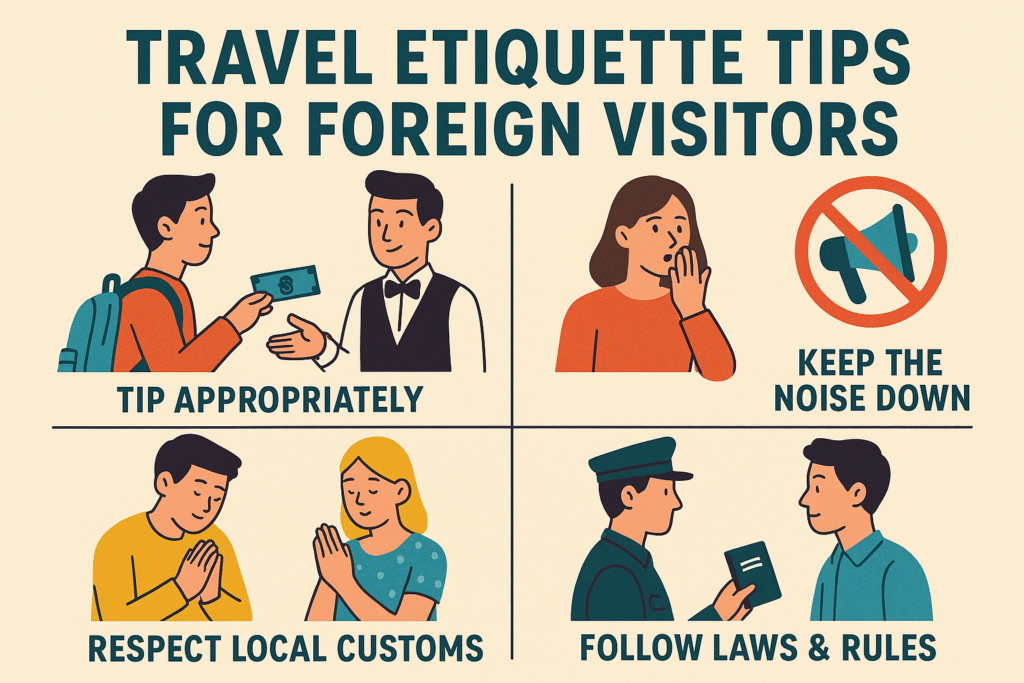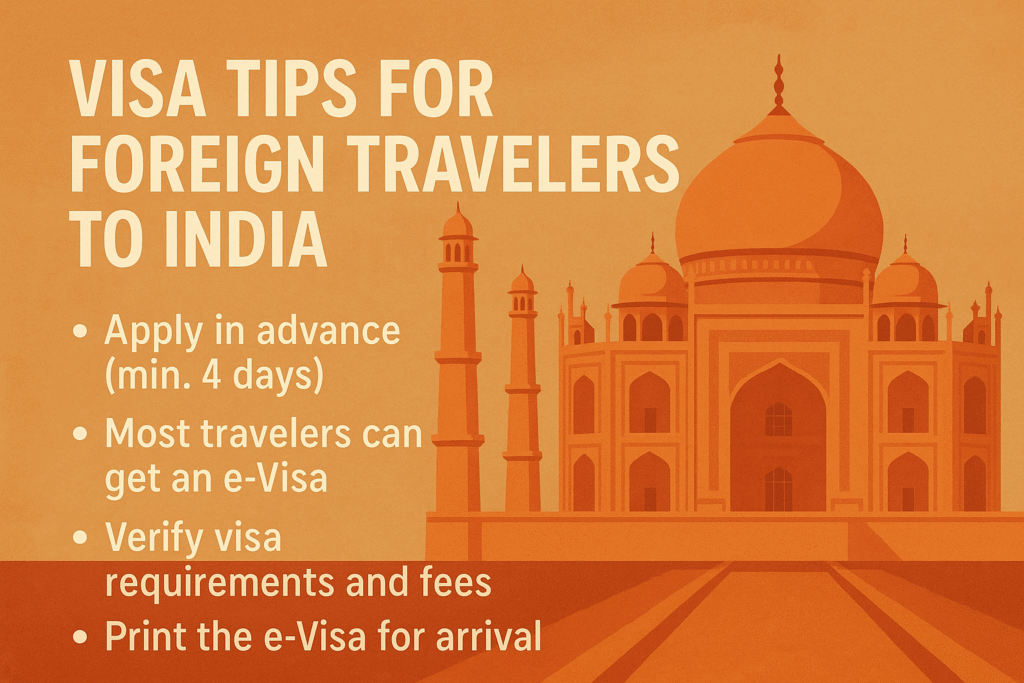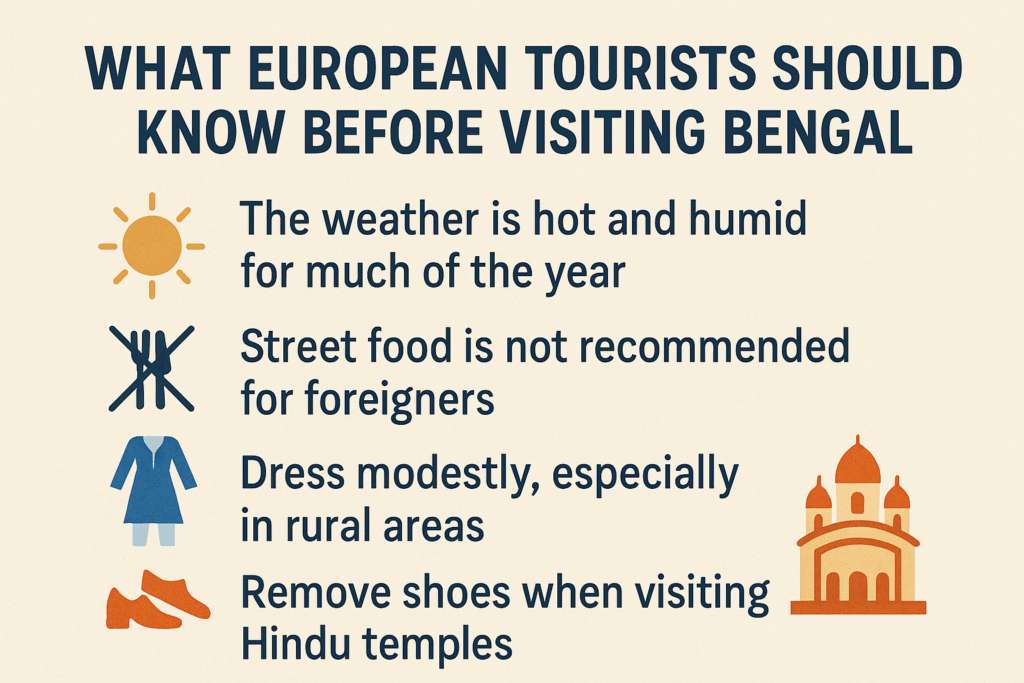🙏 Travel Etiquette Tips for Foreign Visitors – Respectful Tourism in India (2025)
Visiting India soon? Learn essential travel etiquette tips for foreign visitors—covering culture, temples, dress code, food, and behavior. From TheIndiaTourism.in.
🧭 Introduction: Travel with Respect, Not Just a Camera
India is a land of warmth and welcome—but also deep tradition and cultural diversity. As a foreign visitor, being mindful of local customs and etiquette is not just polite—it creates richer, more meaningful travel experiences.
In this article, we share the most important travel etiquette tips for foreign visitors so you can explore India with grace, confidence, and cultural sensitivity. Especially useful for those visiting spiritual and rural areas of Bengal, Uttarakhand, Tamil Nadu, and beyond.
🛕 1. Temple & Religious Site Etiquette
| Do ✅ | Don’t ❌ |
|---|---|
| Remove shoes before entering | Never wear shoes inside temples |
| Dress modestly (shoulders/knees covered) | Avoid tank tops, shorts |
| Respect local rituals and silence | Don’t interrupt or take flash photos |
| Ask before taking photos | Never photograph idols without permission |
📌 Tip: Carry a lightweight scarf or shawl in your daypack for temple visits.
👗 2. Dress Code for Foreign Tourists
-
Loose, breathable clothing is ideal for India’s climate
-
In rural/spiritual regions (like Mayapur, Gangasagar, Varanasi), wear full-length trousers and sleeved tops
-
In beaches like Mandarmani or Goa, swimwear is fine—but only near the water
✅ Local styles like kurta, salwar, or pashmina shawl are widely accepted and comfortable!
🍽️ 3. Dining Etiquette & Food Tips
-
Eat with your right hand (left hand is considered unclean)
-
Always wash your hands before and after meals
-
Many Indian families eat sitting on the floor—accept this as a sign of respect if invited
-
Be open to vegetarian meals—it’s common in many Indian homes and religious sites
🚱 Avoid tap water; stick to sealed bottled water
🗣️ 4. Communication & Gestures
| Action | Meaning |
|---|---|
| “Namaste” (palms together) | Traditional Indian greeting |
| Nod side-to-side (not up-down) | Often means “yes” in Indian culture |
| Public touch/hugging | Not common, especially with the opposite sex |
| Direct confrontation | Avoid—stay calm and polite |
📌 English is widely spoken in cities, but a few Hindi or Bengali phrases go a long way.
💑 5. Public Behavior & Social Norms
-
Avoid public displays of affection (hugging/kissing) in public
-
Queue in lines patiently—even when others don’t
-
Don’t raise your voice when bargaining or asking for help
-
Always remove footwear before entering homes or sacred spaces
✅ Be extra respectful in ashrams, gurudwaras, mosques, and rural villages
🧳 6. Tipping & Hospitality
| Service Type | Tipping Suggestion |
|---|---|
| Restaurants | 5–10% (if not included) |
| Hotel porters | ₹50–₹100 per bag |
| Guides/Drivers | ₹300–₹500/day |
| Street vendors | Not expected |
💡 If offered tea or food in someone’s home or shop, it’s polite to accept at least a sip or bite
🔗 Suggestions
❓FAQs: Travel Etiquette Tips for Foreign Visitors
Can I wear western clothes in India?
Yes—but modest clothing is preferred. Cover shoulders and knees, especially in temples or rural areas.
Is it rude to say no to food when offered?
Not rude, but try to gracefully accept a small portion as a sign of respect—especially in homestays or villages.
Are there any gestures considered disrespectful?
Yes—pointing with your finger, touching someone’s head, or using the left hand to give/receive are best avoided.
🌼 Conclusion: Respect Earns the Richest Experiences
India is one of the world’s most soulful destinations—and it rewards those who approach it with humility and cultural respect. By following these travel etiquette tips for foreign visitors, you won’t just avoid offense—you’ll connect more deeply with the land and its people.
Let TheIndiaTourism.in be your trusted companion as you explore India respectfully, responsibly, and with wide-open eyes.


